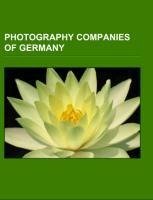
-
 Anglický jazyk
Anglický jazyk
Photography companies of Germany
Autor: Source: Wikipedia
Source: Wikipedia. Pages: 40. Chapters: Exakta, Leica Camera, Carl Zeiss AG, Contax, Schneider Kreuznach, Rollei, Wirgin, Praktica, Arri, Pentacon, Ihagee, AgfaPhoto, Linhof, Voigtländer, Carl Braun Camera-Werk, Soligor, ADOX, Metz, Goerz, Edixa, Leidolf,... Viac o knihe
Na objednávku
16.02 €
bežná cena: 18.20 €
O knihe
Source: Wikipedia. Pages: 40. Chapters: Exakta, Leica Camera, Carl Zeiss AG, Contax, Schneider Kreuznach, Rollei, Wirgin, Praktica, Arri, Pentacon, Ihagee, AgfaPhoto, Linhof, Voigtländer, Carl Braun Camera-Werk, Soligor, ADOX, Metz, Goerz, Edixa, Leidolf, Carl-Zeiss-Stiftung, Otto Berning, Maco. Excerpt: Ur-Leica ("original Leica"), from 1914Leica Camera AG, a German optics company, produces Leica cameras. The predecessor of the company, formerly Ernst Leitz GmbH, is now three companies: Leica Camera AG, Leica Geosystems AG, and Leica Microsystems AG, producing cameras, geosurvey equipment, and microscopes, respectively. Leica Microsystems AG is the owner of the Leica brand, and grants licences to Leica Camera AG and Leica Geosystems. Reproduction of the Leica Prototype, 1913, 1:3,5The first Leica prototypes were built by Oskar Barnack at Ernst Leitz Optische Werke, Wetzlar, in 1913. Intended as a compact camera for landscape photography, particularly during mountain trips, the Leica was the first practical 35 mm camera, using standard cinema 35 mm film. The Leica transports the film horizontally, extending the frame size to 24×36 mm, instead of the 18×24 mm used by cinema cameras which transported the film vertically, with a 2:3 aspect ratio. The Leica went through several iterations, and in 1923 Barnack convinced his boss, Ernst Leitz II, to make a prototype series of 31. The camera was an immediate success when introduced at the 1925 Leipzig Spring Fair as the Leica I (for Leitz camera). The focal plane shutter had a range from 1/20 to 1/500 second, in addition to a Z for Zeit (time) position. Because Barnack's concept for the Leica was to use a small camera, producing a small negative, to make a big picture by enlargement, ("small negative, large picture" concept) the camera needed high quality lenses to create sharp negatives. The first Leica lens was a 50 mm f/3.5 design based on the Cooke triplet of 1893 adapted by Professor Max Berek at Leitz. The lens had five elements in three groups and was called the Leitz Anastigmat. Unlike other triplets, the Leitz Anastigmat had the diaphragm placed between the first and second elements. This lens was later renamed the ELMAX, for E Leitz and MAX Berek. By 1925 the Leitz laboratories had produced glasses with improved
- Vydavateľstvo: Books LLC, Reference Series
- Rok vydania: 2013
- Formát: Paperback
- Rozmer: 246 x 189 mm
- Jazyk: Anglický jazyk
- ISBN: 9781233145010


 Nemecký jazyk
Nemecký jazyk 








